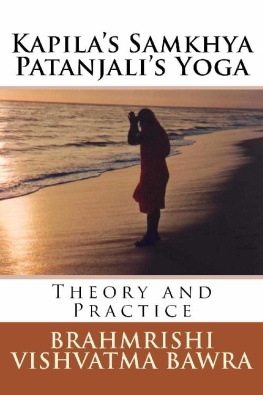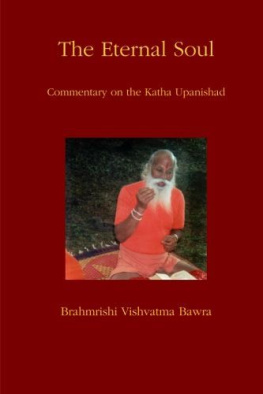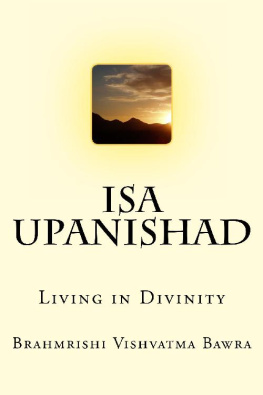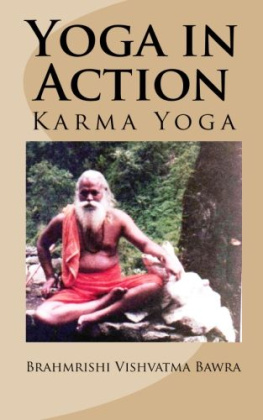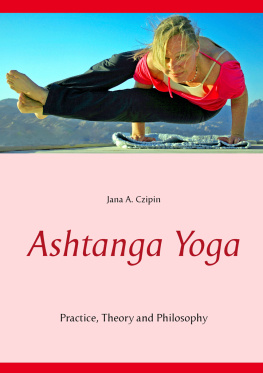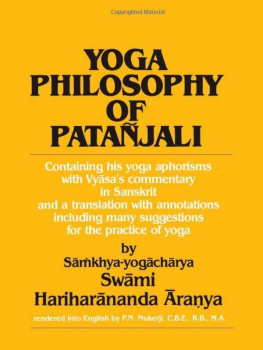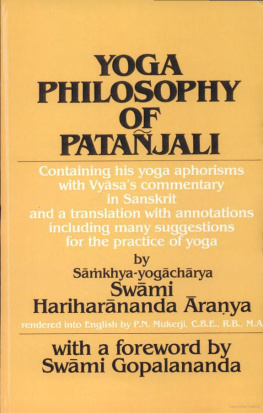Brahmrishi Vishvatma Bawra - Kapilas Samkhya Patanjalis Yoga: Theory and Practice
Here you can read online Brahmrishi Vishvatma Bawra - Kapilas Samkhya Patanjalis Yoga: Theory and Practice full text of the book (entire story) in english for free. Download pdf and epub, get meaning, cover and reviews about this ebook. year: 2012, publisher: Brahmrishi Yoga Publications, genre: Religion. Description of the work, (preface) as well as reviews are available. Best literature library LitArk.com created for fans of good reading and offers a wide selection of genres:
Romance novel
Science fiction
Adventure
Detective
Science
History
Home and family
Prose
Art
Politics
Computer
Non-fiction
Religion
Business
Children
Humor
Choose a favorite category and find really read worthwhile books. Enjoy immersion in the world of imagination, feel the emotions of the characters or learn something new for yourself, make an fascinating discovery.
- Book:Kapilas Samkhya Patanjalis Yoga: Theory and Practice
- Author:
- Publisher:Brahmrishi Yoga Publications
- Genre:
- Year:2012
- Rating:5 / 5
- Favourites:Add to favourites
- Your mark:
- 100
- 1
- 2
- 3
- 4
- 5
Kapilas Samkhya Patanjalis Yoga: Theory and Practice: summary, description and annotation
We offer to read an annotation, description, summary or preface (depends on what the author of the book "Kapilas Samkhya Patanjalis Yoga: Theory and Practice" wrote himself). If you haven't found the necessary information about the book — write in the comments, we will try to find it.
Brahmrishi Vishvatma Bawra: author's other books
Who wrote Kapilas Samkhya Patanjalis Yoga: Theory and Practice? Find out the surname, the name of the author of the book and a list of all author's works by series.
Kapilas Samkhya Patanjalis Yoga: Theory and Practice — read online for free the complete book (whole text) full work
Below is the text of the book, divided by pages. System saving the place of the last page read, allows you to conveniently read the book "Kapilas Samkhya Patanjalis Yoga: Theory and Practice" online for free, without having to search again every time where you left off. Put a bookmark, and you can go to the page where you finished reading at any time.
Font size:
Interval:
Bookmark:
Kapilas Smkhya
Patajalis Yoga
Theory and Practice
Third Edition
Inspired from Lectures of
Brahmrishi Vishvatma Bawra
Compiled and Edited by
William and Margot Milcetich
Brahmrishi Yoga Publications
Originally published as Kapils Smkhya Patajalis Yoga, Brahmrishi Yoga Publications, 2008
Revised 2012.
Third Edition 2018
Publisher: Brahmrishi Yoga Publications
c/o BrahmrishiYoga.org
Brahmrishi Yoga Publications
All rights reserved
Printed in the United States of America
No part of this book may be used or reproduced in any manner without written permission, except in the case of brief quotations embodied in critical articles and reviews.
For information, contact brahmrishiyoga.org
Library of Congress Control Number: 2012906241
ISBN: 978-1475127850
Acknowledgement
We stand in awe of this ancient, oral tradition and we are indebted to our Gurus insights that made this knowledge accessible to us.
We are greatly indebted to the literary skills of many people over the years, most recently Lisa Thiel and Keith Lazuka in this third edition. Their dedication and sincere efforts to grasp and preserve the meaning have enriched this presentation.
In honor of Swami Bawras vision for education, all proceeds of this book will go to a free school established by him in Jabalpur, India. Didi Gyaneshwari has brought the vision of Swami Bawra into a flourishing reality. Brahmrishi Yoga is delighted to participate in this unfoldment.
William & Margot Milcetich
Prefac e i
Introductio n
Smkhya
- How to Remove Pai n
- Eight Root Causes
- Sixteen Modification s
- Purush a
- Three Attribute s
- Evolution and Involutio n
- Three Causes of Sufferin g
- Five Sources of Knowledg e
- Five Causes of Actio n
- Five Wind s
- Five Essences of Actio n
- Five Knots of Ignoranc e
- Twenty-eightfold Inabilitie s
- Nine Satisfaction s
- Eight Gift s
- Ten Root Object s
- Emanation is Accumulatio n
- Fourteen States of Manifested Being s
- Threefold Bondag e
- Threefold Liberatio n
- Three Proof s
- Conclusio n
Yoga
Samadhi Pada/Stable Intellect
I/1-I/4 Definition of Yog a
I/12-I/22 Practice and Detachmen t
I/23I/51 Devotional Practic e
Sadhana Pada/Practice
II/1-II/27 Integrated Practic e
II/28-II/55 Eight Limbed Pat h
Vibhuti Padi/Accomplishments
III/1-III/3 Dhran, Dhyna, Samdh i
Glossar y
Bibliograph y
Brahmrishi Vishvatma Bawra was born in a small Indian village near Varanasi in 1934. As a child, he shied away from school and had no formal education. At the age of eighteen, he was enlightened by the touch of a great yogi , Bhagvan Chandra Mauli, and remembered many previous lives spent with his guru. Under his gurus guidance, Swami Bawra left his family to study higher spiritual practices in Ayodhya at the principal center of the Vaishnava Order. By the grace of his master he received a distinctive memory of scripture and philosophical treatises. He became a learned yogi of the Vaishnava Sanyasi Order. After a period of time, his master insisted he return to society and help humanity.
Swami Bawra hesitated to leave his spiritual ecstasy, but followed his masters guidance. With only a loincloth and a small bag with Holy Scriptures, he traveled throughout India begging alms and giving lectures on the Bhagavad Gt , Rmyana , Upanishads, Smkhya, Yoga, and Vednta philosophies. In his lectures, he shared philosophy in the light of modern science. After twelve years of wandering, at the request of his disciples, Swami Bawra agreed to establish a center for spiritual practice. The first center was inaugurated in 1965, and his mission eventually became an international organization. Swami Bawra also founded numerous schools to provide education for poor children in the villages of India.
Swami Bawras teachings emphasize the spiritual science of Brahma Vidy , knowledge of the source of life in Brahman, which has two aspects, theory and practice. In the Upanishads and Bhagavad Gt , the theory is called Smkhya, and its practical aspect is called Yoga. On the basis of his own experiences, Swami Bawra taught Maha Yoga , an integrated practice of thought and breath for realizing self and finding freedom from suffering.
Swami Bawra traveled to the United States, Canada, and England to share his knowledge. Margot and I studied with him when he traveled, and we periodically went to India to study and meditate with him there. Swami Bawra encouraged me to remain in my professional career while continuing a practice of deep meditation and regular study. Margot began teaching meditation in 1976 and became a yoga teacher in 1982. For many years, we have jointly led meditation and study sessions based on Swami Bawras teachings.
In 2005, Margot founded Brahmrishi Yoga Teacher Training. Swami Bawras inspiration and guidance on the need for Western practitioners to understand Smkhya is the core of this training. In 2006, I retired from my professional career and began to teach meditation and assist with philosophical presentations. We both felt a need for an English commentary incorporating Swami Bawras revival of Smkhya as the basis for our teaching.
Margot had compiled and edited a series of lectures given on Tattva Samasa , a brief outline of Kapilas Smkhya. She wanted this worked into a presentation on the practices enumerated in the Yoga Stras to highlight and emphasize their philosophical basis. Subsequently, I found additional lectures Swami Bawra had given on Tattva Samasa . This commentary on Smkhya is a compilation of all these lectures, as well as additional supplemental material.
Likewise, the Yoga section is compiled from lectures on the first two chapters of Patajali's Yoga Stras. I collected, transcribed, compiled, and edited this material, supplementing it with previous works and other lectures of Swami Bawra to create this commentary.
Our intent is to provide an understanding of the philosophical foundation and practical methods for achieving inner freedom. We begin with a commentary on Tattva Samsa , which outlines Kapilas philosophy and serves as the theoretical base necessary for understanding Yoga. This is followed by a selection of Patajalis Yoga Stras , which illuminate the aim, principles and methods of Yoga.
William Milcetich
Pronunciation: To assist English readers with the pronunciation of frequently used Sanskrit terms, letters have been added to the strict transliteration of Sanskrit to English. For example, purua is written as purusha and prakriti as prakriti . The long vowels of a, i, and u are indicated by the symbols, , , and and the sh sound is indicated by .
There are six systems of Vedic thought that pair to form three primary philosophical schools. Each of these systems relies on and interprets the Vedas, ancient texts of knowledge realized by the seers thousands of years ago. All systems summarize the gist of their teaching in the form of short stras , which theorize the cause of life and offer a practical means for living free from suffering. Commentaries explain and elaborate on the meaning of these stras .
 The oldest school is Smkhya, an analysis of nature and spirit, paired with Yoga, a treatise on method. Vaiesika, atomic theory, is linked to Nyya, logic. Vednta, a theory of absolute truth, pairs with Prva Mmms, duty. The original teachers of these systems are Kapila of Smkhya and Hiranyagarbha of Yoga; Kanada of Vaiesika and Gautama of Nyya; and Vysa of Vednta and Jaimini of Prva Mmms. There are no written documents credited to Hiranyagarbha, so we are indebted to the work of Patajali who compiled the ancient teaching of Yoga.
The oldest school is Smkhya, an analysis of nature and spirit, paired with Yoga, a treatise on method. Vaiesika, atomic theory, is linked to Nyya, logic. Vednta, a theory of absolute truth, pairs with Prva Mmms, duty. The original teachers of these systems are Kapila of Smkhya and Hiranyagarbha of Yoga; Kanada of Vaiesika and Gautama of Nyya; and Vysa of Vednta and Jaimini of Prva Mmms. There are no written documents credited to Hiranyagarbha, so we are indebted to the work of Patajali who compiled the ancient teaching of Yoga.
Font size:
Interval:
Bookmark:
Similar books «Kapilas Samkhya Patanjalis Yoga: Theory and Practice»
Look at similar books to Kapilas Samkhya Patanjalis Yoga: Theory and Practice. We have selected literature similar in name and meaning in the hope of providing readers with more options to find new, interesting, not yet read works.
Discussion, reviews of the book Kapilas Samkhya Patanjalis Yoga: Theory and Practice and just readers' own opinions. Leave your comments, write what you think about the work, its meaning or the main characters. Specify what exactly you liked and what you didn't like, and why you think so.

